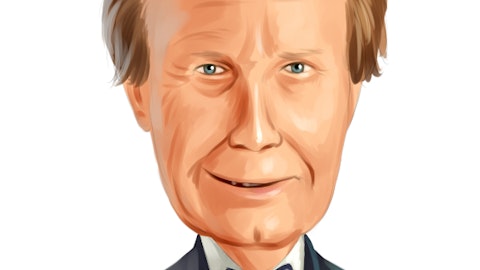Brooks O’Neil: Great. Thank you for all that color and I can tell you I am excited about your future.
Tim Arens: Thank you, Brooks. We are too.
Operator: Our next question comes from Mike Petusky with Barrington Research. Please go ahead.
Mike Petusky: Hey Good morning. So Tim, just in terms of the assumption around second half — I’m sorry first half calendar commercial launch for SurVeil obviously that’s — there’s I guess 180 days range in there. And your assumption you have to be assuming something there. I mean is it fair to say you’re assuming somewhere in the middle of that time frame in terms of the $13.5 million or the part of that the $13.5 million that’s the contribution from SurVeil? Are you assuming sort of just that that’s commercialized for essentially the last three months of your fiscal? Can you just talk about what you’re actually specifically assuming to get to the contribution you’re assuming for the — within the $13.5 million?
Gary Maharaj: Yeah. I’ll say one thing and I’ll turn it over to Tim for the detailed answer. One of the things in the partnership with Abbott we recognize the competitive dynamics of a launch and the things that they’re trying to set up. And so if there’s any implied vagueness, it’s because we want to respect our confidentiality as they really gear up for a major launch. So that explains the wide window even though we know what the window really is. We want to give them every opportunity to compete effectively with their launch planning.
Tim Arens: Yeah. And thank you, Mike, it’s a very appropriate question. And as Gary kind of got in front of my answer here I’m limited in terms of what I can specifically say with regard to Abbott, but I can provide some color and think for folks to probably appreciate is that, the first half of the year will reflect the stocking order that we are — we’ve been manufacturing and sending to Abbott. And so clearly, the second half of the year is going to be more influenced by Abbott reorders, once they’re in the market, and have commercialized the technology in the product. So I think that’s probably the extent of context that, I can provide today.
Mike Petusky: Could I just ask are you assuming any profit share dollars in — within whatever contribution you’re assuming in the $13.5 million?
Tim Arens: We will and they’re very modest. We’ll need some time. Obviously, it is an estimation. It’s a judgment and just to probably provide a little clarity for folks, we will need to make assumptions with regard to the units that we ship to Abbott, how many will actually be sold. How many will be used for promotional activities, how much will be expired. We’ll have to make assumptions with regard to their selling price. So there is a bit of a number of variables that we need to estimate. And as you can imagine, we’ll learn more about how to think about these variables once Abbott estimates, but know that it’s a modest portion of that $13.5 million that I described.
Gary Maharaj: Yes. Refining — first year, we’ll refine that model but you can imagine the first year predictability without those assumptions and history of those assumptions being validated it’s going to be challenging for us.
Mike Petusky: All right. But there is some estimate of that. I’m assuming that’s like on a 90-day trail. Is that right?
Tim Arens: So we’ll make the estimate at the time we ship product to Abbott, but there will be a true-up to think of how Surmodics actually goes about estimating our royalty revenue then we collect the actual royalty payments and there is a true-up or an adjustment based upon our estimate versus what we receive. That will happen over time with Abbott as well.
Mike Petusky: 90 days or further out from that?
Tim Arens: It will be quarterly.
Mike Petusky: Okay. All right. And then last question I’ve stretched the boundary of two questions, but let me just ask the last question. I guess in terms of the sales effort on Pounce and Sublime Gary, do you expect that now that you guys are in a better situation in terms of sort of the outlook for the future and sort of the vision there and frankly the balance sheet does more investment in the sales team there makes sense at this point? Thanks.
Gary Maharaj: If we didn’t have — the short answer is yes, but it will be grow as we go. So in other words as we start generating returns from that business we’ll be investing it in that business. We have drawn a line on what we should be investing on a go-forward basis to show our cash — so pay attention to our cash forecast, right? Usually, it’s revenue and earnings but cash is an appropriate throttle limiter for where the company is right now. Could we go faster? I believe so, but we don’t want to become a balance sheet story as a public company in this macroeconomic condition. So we’ll grow as we go. We’re not going to double the size of the sales force I can tell you that. But we will be selectively adding. Another key thing is, when we do launch the Pounce Venous right we’ll have to be interpreting whether we can go faster again in a very disciplined fashion with some more feet on the street.
The one thing we have to say is as you get GPO contracts which is — I don’t know how to emphasize this which is remarkable for a company at this stage, right? Now in GPO contracts and IDN contracts you have to demonstrate penetration in that contract. So now you’re covering an extra 100 hospitals. And so we will be doing an analysis of where the heat maps are to seed our territory managers and field clinical specialists, but we can’t over accelerate there. That’s the big discipline we have to put in place this year.
Mike Petusky: Can I just ask a quick follow-up and this is sort of a big picture longer term? I mean, if we’re having this conversation three years from now and Venous has obviously been commercialized at that point for two-plus years, I mean, it is possible that there could be a doubling of the sales force isn’t it at that point?

